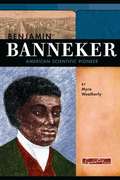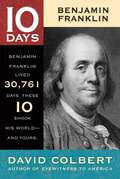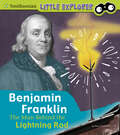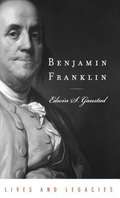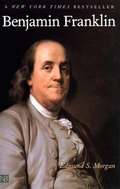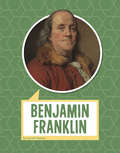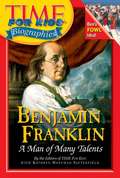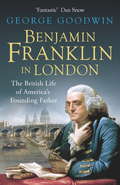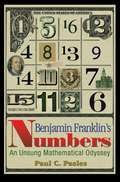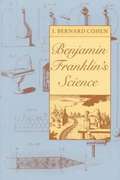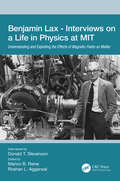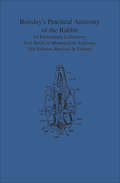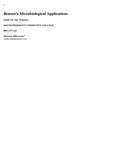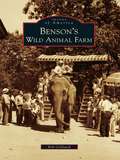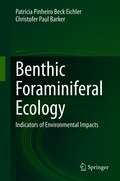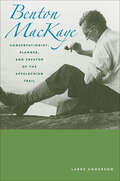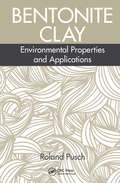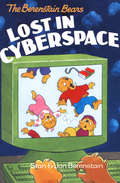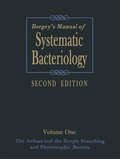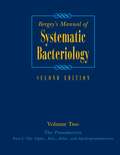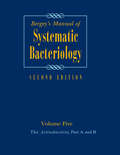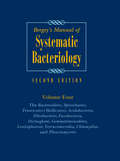- Table View
- List View
Benjamin Banneker: American Scientific Pioneer
by Myra S. WeatherlyA biography profiling the life of scientist and mathematician Benjamin Banneker. Includes source notes and timeline.
Benjamin Franklin: Benjamin Franklin (10 Days)
by David ColbertBestselling author David Colbert examines the life of Benjamin Franklin by looking at the ten most important days of his life—days that changed the world.You're about to be an eyewitness to the top ten days in Ben Franklin's life, including: -A cunning escape from a cruel brother. -A shrewd plan to save the colonies. -A treacherous spy game in Paris. -A shocking battle with a vengeful aristocrat. -And a last-minute triumph that bound American together. These days and five others shook Franklin's world—and yours.
Benjamin Franklin: The Man Behind the Lightning Rod (Little Inventor)
by Nancy DickmannWhy is Benjamin Franklin important? He invented the lightning rod and much more! Readers follow the journey of this inventor and founding father. Franklin created the lightning rod and other inventions that helped change the world. It's an electrifying story filled with engaging text and colorful images, all reviewed by Smithsonian experts.
Benjamin Franklin
by Edwin S. GaustadThe tenth and youngest son of a poor Boston soapmaker, Benjamin Franklin would rise to become, in Thomas Jefferson's words, "the greatest man and ornament of his age. " In this short, engaging biography, historian Edwin S. Gaustad offers a marvelous portrait of this towering colonial figure, illuminating Franklin's character and personality. Here is truly one of the most extraordinary lives imaginable, a man who, with only two years of formal education, became a printer, publisher,postmaster, philosopher, world-class scientist and inventor, statesman, musician, and abolitionist. Gaustad presents a chronological account of all these accomplishments, delightfully spiced with quotations from Franklin's own extensive writings. The book describes how the hardworking Franklin became at age 24 the most successful printer in Pennsylvania and how by 42, with the help of Poor Richard's Almanack, he had amassed enough wealth to retire from business. We then follow Franklin's nextbrilliant career, as an inventor and scientist, examining his pioneering work on electricity and his inventions of the Franklin Stove, the lightning rod, and bifocals, as well as his mapping of the Gulf Stream, a major contribution to navigation. Lastly, the book covers Franklin's role as America's leading statesman, ranging from his years in England before the Revolutionary War to his time in France thereafter, highlighting his many contributions to the cause of liberty. Along the way, Gaustad sheds light on Franklin's personal life, including his troubled relationship with his illegitimate son William, who remained a Loyalist during the Revolution, and Franklin's thoughts on such topics as religion and morality. Written by a leading authority on colonial America, this compact biography captures in a remarkably small space one of the most protean lives in our nation's history.
Benjamin Franklin
by Edmund Sears MorganShort biography of Benjamin Franklin by a historian who has numerous books to his credit along with numerous awards.
Benjamin Franklin (Biographies)
by Laura K. MurrayHow much do you know about Benjamin Franklin? Find out the facts you need to know about this Founding Father, author, and inventor. You'll learn about the early life, challenges, and major accomplishments of this important American.
Benjamin Franklin: A Man of Many Talents
by Kathryn Hoffman Satterfield Editors of TIME FOR KIDSA brief biography highlights some of the achievements of one of the most famous men from the early years of the United States.
Benjamin Franklin in London: The British Life of America's Founding Father
by George Goodwin'Sensitive, moving and finely textured' Guardian'Fantastic' Dan SnowFor the great majority of his long life, Benjamin Franklin was a loyal British royalist. In 1757, having made his fortune in Philadelphia and established his fame as a renowned experimental scientist, he crossed the Atlantic to live as a gentleman in the heaving metropolis of London. With just a brief interlude, a house in Craven Street was to be his home until 1775. From there he mixed with both the brilliant and the powerful, whether in London coffee house clubs, at the Royal Society, or on his summer travels around the British Isles and continental Europe. He counted David Hume, Matthew Boulton, Joseph Priestley, Edmund Burke and Erasmus Darwin among his friends, and as an American colonial representative he had access to successive Prime Ministers and even the King.The early 1760s saw Britain's elevation to global superpower status with victory in the Seven Years War and the succession of the young, active George III. These two events brought a sharp new edge to political competition in London and redefined the relationship between Britain and its colonies. Though Franklin long sought to prevent the break with Great Britain, his own actions would finally help cause that very event. On the eve of the American War of Independence, Franklin fled arrest and escaped by sea. He would never return to London. With his unique focus on the fullness of Benjamin Franklin's life in London, George Goodwin has created an enthralling portrait of the man, the city and the age.
Benjamin Franklin's Numbers: An Unsung Mathematical Odyssey
by Paul C. PaslesFew American lives have been as celebrated--or as closely scrutinized--as that of Benjamin Franklin. Yet until now Franklin's biographers have downplayed his interest in mathematics, at best portraying it as the idle musings of a brilliant and ever-restless mind. In Benjamin Franklin's Numbers, Paul Pasles reveals a side of the iconic statesman, scientist, and writer that few Americans know--his mathematical side. In fact, Franklin indulged in many areas of mathematics, including number theory, geometry, statistics, and economics. In this generously illustrated book, Pasles gives us the first mathematical biography of Benjamin Franklin. He draws upon previously unknown sources to illustrate Franklin's genius for numbers as never before. Magic squares and circles were a lifelong fascination of Franklin's. Here, for the first time, Pasles gathers every one of these marvelous creations together in one place. He explains the mathematics behind them and Franklin's hugely popular Poor Richard's Almanac, which featured such things as population estimates and a host of mathematical digressions. Pasles even includes optional math problems that challenge readers to match wits with the bespectacled Founding Father himself. Written for a general audience, this book assumes no technical skills beyond basic arithmetic. Benjamin Franklin's Numbers is a delightful blend of biography, history, and popular mathematics. If you think you already know Franklin's story, this entertaining and richly detailed book will make you think again.
Benjamin Franklin's Science
by I. Bernard CohenBenjamin Franklin is well known to most of us, yet his fundamental and wide-ranging contributions to science are still not adequately understood. Until now he has usually been incorrectly regarded as a practical inventor and tinkerer rather than a scientific thinker. He was elected to membership in the elite Royal Society because his experiments and original theory of electricity had made a science of that new subject. His popular fame came from his two lightning experimentsâe"the sentry-box experiment and the later and more famous experiment of the kiteâe"which confirmed his theoretical speculations about the identity of electricity and provided a basis for the practical invention of the lightning rod. Franklin advanced the eighteenth-century understanding of all phenomena of electricity and provided a model for experimental science in general. I. Bernard Cohen, an eminent historian of science and the principal elucidator of Franklinâe(tm)s scientific work, examines his activities in fields ranging from heat to astronomy. He provides masterful accounts of the theoretical background of Franklinâe(tm)s science (especially his study of Newton), the experiments he performed, and their influence throughout Europe as well as the United States. Cohen emphasizes that Franklinâe(tm)s political and diplomatic career cannot be understood apart from his scientific activities, which established his reputation and brought him into contact with leaders of British and European society. A supplement by Samuel J. Edgerton considers Franklinâe(tm)s attempts to improve the design of heating stoves, another practical application that arose from theoretical interests. This volume will be valuable to all readers wanting to learn more about Franklin and to gain a deeper appreciation of the development of science in America.
Benjamin Lax - Interviews on a Life in Physics at MIT: Understanding and Exploiting the Effects of Magnetic Fields on Matter
by Donald Stevenson Marion Reine Roshan L. AggarwalThis book covers the life and 60-year career of Prof. Benjamin Lax (1915-2015), a preeminent physicist at the Massachusetts Institute of Technology (MIT), who played major roles in the development and applications of solid state and plasma physics. In an extensive series of autobiographical interviews, Lax describes the challenges he overcame, the opportunities he embraced, and the many outstanding research physicists he recruited, mentored, and interacted with. He includes both personal and professional reminiscences. Lax begins with his earliest memories of his childhood in Hungary. He recalls the immigration of his family to America and his education in New York City. He describes his Army service as a Radar Officer at the MIT Radiation Laboratory during World War II. He covers his graduate education in physics at MIT, and his building up the semiconductor and ferrite research groups at MIT Lincoln Laboratory in the 1950s. He describes the origins and accomplishments of the MIT Francis Bitter National Magnet Laboratory, of which he was the founding Director, and recalls his tenure as professor in the MIT physics department. Features: Provides a valuable insight into a 60-year career in physics at one of the world’s major research universities, the Massachusetts Institute of Technology Explores the organization, funding, and conduct of solid state physics research in the second half of the twentieth century Includes a complete bibliography of Lax’s publications in an on-line supplement
Bensley's Practical Anatomy of the Rabbit: An Elementary Laboratory Text-Book in Mammalian Anatomy (Eighth Edition, Revised and Edited)
by E. Horne CraigieThe anatomical study of an animal is chiefly a matter of applying a certain practical method of exposition, the student's attention being concentrated on those facts which can be made out by direct observation. This method is educative in the technical sense because it involves accurate discernment of detail, and because, as a means of obtaining first-hand information, it is the foundation of laboratory practice. This being the case, it is a very pertinent question what is the best procedure. So far, as the present book is concerned, it is expected that the study of the type will begin with at least a preliminary survey of the prepared skeleton (Part II). This will be followed by dissection (Part III), in which the order by sections will be found of less importance than that of details in any particular region and and in which portions of the skeleton related to the part under examination may be included.The regional method of approach is indicated rather than the more complete study of single systems, partly for the sake of economy of material and partly in belief that this aids understanding of the topographical and other interrelations between systems, encouraging the building up of a conception of the individual organism as an integrated unit.The general matter of Part I is purely accessory and, though necessarily incomplete in many ways, is designed to afford a comprehensive view of the various factors upon which mammalian structure depends. It will be found that only the first few chapters are introductory in most respects, the remainder being rather explanatory and hence most valuable if used to supplement the directions for dissection as this is carried out.In preparation of the eighth edition of the Practical Anatomy of the Rabbit use has been made of extensive notes recorded in the laboratory during successive years of employment of the previous edition. All relevant questions raised by students or other instructors for which an adequate answer was found not to be readily available in the text have been noted and an attempt has been made to provide answers for them in the revisions. The whole text has been searchingly surveyed with the result that many small changes have been made, parts have been expanded, and a few have been entirely rewritten.
Benson's Microbiological Applications
by WheelerBenson’s Microbiological Applications has been the gold standard of microbiology laboratory manuals for more than 35 years. This manual has a number of attractive features that resulted in its adoption in universities, colleges, and community colleges for a wide variety of microbiology courses. <p><p>These features include user- friendly diagrams that students can easily follow, clear instructions, and an excellent array of reliable exercises suitable for beginning or advanced microbiology courses.
Benson's Wild Animal Farm
by Bob GoldsackBenson's Wild Animal Farm in Hudson, New Hampshire, opened to the public in 1927. Due in part to the evolution of the automobile, the attraction grew in size and attendance to become one of New England's major family destinations. Benson's was a zoo to the public, a work station for many circus animal trainers and performers, and a source of summer employment for generations of local teenagers. The attraction closed in 1987 and a bit of Americana faded away, but its memory remains vivid to many. The property was sold to the state for the development of a highway, which never materialized. In 2009, after years of negotiations, the town purchased the land from the New Hampshire Department of Transportation with plans to develop it into a large park filled with picnic areas, walking paths, and bicycle trails. A Benson's museum is planned for the future.
Bent-Shaped Liquid Crystals: Structures and Physical Properties (Liquid Crystals Book Series)
by Hideo Takezoe Alexey EreminBent-Shaped Liquid Crystals: Structures and Physical Properties provides insight into the latest developments in the research on liquid crystals formed by bent-shaped mesogens. After a historical introduction, the expert authors discuss different kinds of mesophase structures formed by bent-shaped molecules. This book devotes the majority of its pages to physical properties such as polar switching, optics and non-linear optics, and behavior in restricted geometries. However, as chemistry is often highly relevant to the emergence of new phases, particularly with reflection symmetry breaking, it also involves a broad spectrum of interesting chemistry viewpoints.
Benthic Foraminiferal Ecology: Indicators of Environmental Impacts
by Patrícia Pinheiro Beck Eichler Christofer Paul BarkerThis book provides effective statistical analyses in benthic foraminiferal communities patterns and show solutions for sea-land processes and alterations caused by climate changes and other local (and global) environmental concerns. Our goal is to provide, through these chapters, the monitoring and forecasting of environmental impacts with accurate data. We identify global regions most subject to industrial pollution, contamination and sewage, identifying potential sites prone to accumulate organic matter, which effects erosion, deposition, ocean temperature and pH changes (warming, cooling, acidification), climate and sea-level changes. Benthic habitats, specifically foraminiferal (single celled microorganisms found in the water column and sediment) contribute to our understanding of local and global climate change that effect at risk communities. Derived through the accuracy of oceanographic climate science, allow us to predict with the intention to alleviate potential loss in coastal areas, which are, the most vulnerable to ocean warming, cooling, acidification, and sea-level rise impacts. We unravel the mystery of the Environmental Impacts and Climate Change, helping communities prepare, adjust, adapt, and minimize effects or remediate loss. We show how to pinpoint the most vulnerable and specific sites for economic and social damage and loss, using foraminifera, an inexpensive and easily handled proxy valuable for monitoring coastal and marine environmental stressors.The implications of those problems and the ability to forecast patterns on land are primary issues we address by studying marine sediment of beaches, estuaries, bays and deep water worldwide. Ecology, biology, life history, and taxonomy of modern Foraminifera allows us to examine the current and historical record of environmental change effects, and predict implications for future sea-level rise, and ocean patterns. The prediction of responses of interacting systems to these problems, and development of strategies is needed to inform leadership with the knowledge and data to effectively implement policy, making this book a very informative and significant contribution for researchers and decision makers.
Benton MacKaye: Conservationist, Planner, and Creator of the Appalachian Trail (Creating the North American Landscape)
by Larry AndersonPlanner and originator of the Appalachian Trail and a cofounder of the Wilderness Society, Benton MacKaye (1879-1975) was a pioneer in linking the concepts of preservation and recreation. Spanning three-quarters of a century, his long and productive career had a major impact on emerging movements in conservation, environmentalism, and regional planning. MacKaye's seminal ideas on outdoor recreation, wilderness protection, land-use planning, community development, and transportation have inspired generations of activists, professionals, and adventurers seeking to strike a harmonious balance between human need and the natural environment.This pathbreaking biography provides the first complete portrait of this significant and unique figure in American environmental, intellectual, and cultural history. Drawing on extensive research, Larry Anderson traces MacKaye's extensive career, examines his many published works, and describes the importance of MacKaye's relationships with such influential figures as Lewis Mumford, Aldo Leopold, and Walter Lippmann. This book will appeal to students, scholars, and professionals in preservation, conservation, recreation, planning, and American studies, as well as general readers interested in these subjects.
Bentonite Clay: Environmental Properties and Applications
by Roland PuschStudies the Environmental, Cosmetic, and Pharmaceutical Applications of Bentonite ClayBentonite clay, of which members of the smectite family of clay minerals are particularly important, has proven to be effective in sealing off wastes from groundwater. Bentonite Clay: Environmental Properties and Applications explores the mineralogy of clays in ge
The Berenstain Bears Lost in Cyberspace (I Can Read!)
by Jan Berenstain Stan BerenstainComputers in the classroom send the Bear Country cubs into cyberspace <P><P>The cubs of Bear Country School are in for a real surprise when Squire Grizzly gives each student a computer. With the discovery of the Internet, everyone start to lose focus and forget to do their schoolwork. <P><P>Teacher Bob struggles to bring the pupils out of cyberspace and back to Beartown--and teach them the importance of real-life interaction before it's too late.
Bergbau gleich Raubbau?: Rohstoffgewinnung und Nachhaltigkeit
by Volker WredeRessourcenverknappung durch den Raubbau an der Natur, steigende Rohstoffpreise und die globale Krise der Rohstoffversorgung sind Bedrohungsszenarien, welche uns immer wieder beschäftigen und allzu oft als kaum abwendbares Schicksal erscheinen.Doch wie sieht die Rohstoffsituation in der Welt tatsächlich aus? Wie ist die Tatsache einzuordnen, dass die Menge der bekannten Rohstoffreserven entgegen der naheliegenden Vermutung tatsächlich schneller anwächst als der Rohstoffverbrauch? Müsste man anstelle der Gefahr von Ressourcenknappheit nicht viel eher von einer Rohstofffülle sprechen? Halten die fossilen Rohstoffe länger vor als die Regenerativen?Eine These dieses Buches ist, dass die Gewinnung von Rohstoffen grundsätzlich mit Eingriffen in den Naturhaushalt verbunden ist, die sich dennoch weitgehend umweltverträglich durchführen lassen. Anhand zahlreicher Fallbeispiele wird zudem veranschaulicht, weshalb vergangene Fehlentwicklungen und zweifellos bestehende Missstände keine spezifischen Probleme der Rohstoffwirtschaft darstellen, sondern eher als Abbild der jeweils herrschenden gesellschaftlichen Systeme zu deuten sind.
Bergey's Manual of Systematic Bacteriology: Volume One : The Archaea and the Deeply Branching and Phototrophic Bacteria (Bergey's Manual Of Systematic Bacteriology Ser. #Vol. 1)
by George M. GarrityBacteriologists from all levels of expertise and within all specialties rely on this Manual as one of the most comprehensive and authoritative works. Since publication of the first edition of the Systematics, the field has undergone revolutionary changes, leading to a phylogenetic classification of prokaryotes based on sequencing of the small ribosomal subunit. The list of validly named species has more than doubled since publication of the first edition, and descriptions of over 2000 new and realigned species are included in this new edition along with more in-depth ecological information about individual taxa and extensive introductory essays by leading authorities in the field.
Bergey's Manual® of Systematic Bacteriology: Volume Two: The Proteobacteria (Part C) (Bergey's Manual Of Systematic Bacteriology (springer-verlag) Ser.)
by George Garrity James T. Staley David R. Boone Don J. Brenner Paul De Vos Michael Goodfellow Noel R. Krieg Fred A. Rainey Karl-Heinz SchleiferIncludes a description of the Alpha-, Beta-, Delta-, and Epsilonproteabacteria (1256 pages, 512 figures, and 371 tables). This large taxa include many well known medically and environmentally important groups. Especially notable are Acetobacter, Agrobacterium, Aquospirillum, Brucella, Burkholderia, Caulobacter, Desulfovibrio, Gluconobacter, Hyphomicrobium, Leptothrix, Myxococcus, Neisseria, Paracoccus, Propionibacter, Rhizobium, Rickettsia, Sphingomonas, Thiobacillus, Xanthobacter and 268 additional genera.
Bergey's Manual of Systematic Bacteriology: Volume 5: The Actinobacteria
by Aidan ParteIncludes a revised taxonomic outline for the Actinobacteria or the high G+C Gram positives is based upon the SILVA project as well as a description of greater than 200 genera in 49 families. Includes many medically and industrially important taxa.
Bergey's Manual of Systematic Bacteriology: Volume 4: The Bacteroidetes, Spirochaetes, Tenericutes (Mollicutes), Acidobacteria, Fibrobacteres, Fusobacteria, Dictyoglomi, Gemmatimonadetes, Lentisphaerae, Verrucomicrobia, Chlamydiae, and Planctomycetes (Bergey's Manual Of Systematic Bacteriology (springer-verlag) Ser.)
by Aidan ParteIncludes a revised taxonomic outline for the phyla Bacteroidetes, Planctomycetes, Chlamydiae, Spirochetes, Fibrobacteres, Fusobacteria, Acidobacteria, Verrucomicrobia, Dictyoglomi, and Gemmatimonadetes based upon the SILVA project as well as a description of more than 153 genera in 29 families. Includes many medically important taxa.
